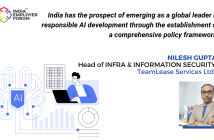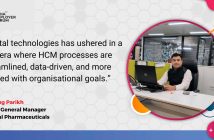The HR function can unlock a tremendous amount of value from the data they already own. This value originates from uncovering patterns and relationships between key pieces of information about people and teams. One of the ways of finding such patterns is through predictive analytics. However, reports suggest that approximately 40% of businesses have adopted platforms, and only close to 50% use Embedded HR Tech Analytics Applications. Such low adoption can be attributed to the lack of awareness of predictive HR analytics among HR professionals. In this Nibandh, we’ll explore the various use cases of Predictive HR Analytics, and how the HR function can implement these applications to optimize operations.
What is Predictive HR Analytics?
The term Predictive Analytics refers to the use of statistics to forecast future outcomes. When applied in the field of HR, we call it Predictive HR Analytics. We can define Predictive HR Analytics as a systematic application of predictive modelling of HR-related data, to make informed judgments about possible causal factors influencing HR-related performance indicators. In other words, Predictive HR Analytics is the use of statistical techniques on the HR data to make useful predictions. Predictive HR Analytics is a boon for the HR function as it can help transform HR from being reactive to more proactive by identifying trends and predicting future outcomes.
The Applications of Predictive HR Analytics
Predictive HR Analytics can be used by to optimize the people supply chains and ensure long term talent retention, higher productivity and enhanced talent management. Let’s delve deeper into the various scenarios in which HR can leverage predictive analytics for better employee outcomes.
Employee Turnover Prediction
The HR function can predict employee turnover by analyzing existing HR data such as employee performance, engagement levels, absenteeism, and job satisfaction. All such data points are collected from various sources such as employee surveys, attendance reports, performance management systems, etc. Methods like logistic regression, decision trees, and machine learning algorithms can be applied to the data to spot patterns and factors that identify employee attrition.
Predicting employee turnover is highly useful because it enables HR teams to proactively address retention issues, identify high-risk employees, and implement targeted interventions. If done efficiently, it can help reduce turnover costs, improve employee satisfaction, and deliver more informed workforce planning.
Predicting Absentiesm
The absence of employees can be predicted by using data points from attendance records, health trends, and work patterns. These data points can go through time series analysis, regression models, and machine learning algorithms to identify patterns that indicate the likelihood of future absences. This allows HR teams to proactively manage potential staffing gaps, predict periods of high absenteeism, and implement preventive measures, such as wellness programs or workload adjustments. By predicting absenteeism, HRs can reduce unplanned leaves, improve workforce productivity, and achieve better scheduling efficiency leading to cost savings and enhanced employee well-being.
Succession Planning
Predictive HR analytics can be used to identify employees suited for future leadership roles and improve succession planning by analyzing key performance indicators, career progression data, employee potential assessments, and behavioral traits. It leverages data such as past performance reviews, leadership assessments, skills development history, engagement levels, and 360-degree feedback. This data typically comes from HR systems, performance management tools, and employee feedback collected through HCM platforms.
By analyzing these data points, predictive analytics can highlight employees who demonstrate leadership potential, identify skill gaps, and suggest personalized development paths. This will help organizations to create stronger leadership pipelines, and reduce the risk of leadership shortages. A well-structured succession plan ensures business continuity, minimizes disruptions, and fosters long-term growth by nurturing internal talent.
Talent Management
Predictive HR analytics plays a crucial role in talent management by helping organizations anticipate future talent needs and identify skill gaps within the workforce. By analyzing employee data such as performance reviews, job competencies, training histories, and market trends, the HR function can predict which skills will be in demand and which employees need development. Based on these insights, HR can build personalized training programs to enhance employee capabilities and prepare them for future roles. This proactive approach helps organizations upskill their workforce and ensure employees are future-ready.
Diversity and Inclusion
The HR function can leverage Predictive HR Analytics to improve its Diversity, Equity and Inclusion (DE&I) initiatives by identifying trends, gaps, and potential biases across the employee lifecycle, from hiring to promotions and retention. By analyzing data on demographics, hiring practices, performance reviews, and employee engagement, it can predict areas where diversity may be lacking and help design more inclusive strategies. It enables organizations to forecast the impact of specific DE&I initiatives, such as targeted recruitment or mentorship programs, and track their effectiveness over time. This data-driven approach to DE&I not only helps create a more equitable workplace but also fosters innovation, employee satisfaction, and stronger business outcomes.
What’s Next?
Predictive analytics is fundamentally based on the field of statistics. Since most of the HR graduation programs do not include an intense study of statistical science, it is difficult for the HR professional to comprehend and implement an elaborate system for predictive analytics in their organizations. To overcome this challenge, HR professionals need to widen their conceptual understanding on this topic by reading more about it. Later, they can learn the fundamentals of statistical techniques like regression analysis, time series analysis, cluster analysis, etc. And finally, they need to learn modern statistical tools like R, SPSS, SAS, etc.
You might also be interested to read: India Needs a Robust AI Policy Framework




